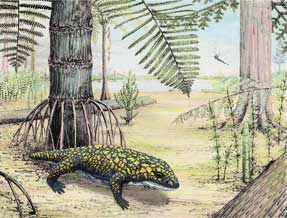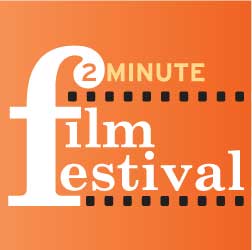 Summer 2010
Summer 2010|
Home-grown discovery
A fossil found right here in Pittsburgh is that of an entirely new species of land-dwelling trematopid amphibian that lived some 300 million years ago. A team of Carnegie Museum of Natural History scientists was charged with the task of studying the specimen, and they announced their surprising finding this past March: that the discovery is important in understanding when this group of animals transitioned to warmer, drier climates.  Illustration: Mark A. KlinglerIn 2004, then University of Pittsburgh junior Adam Striegel picked up the fossil during a geology field trip on property owned by FedEx Ground, near Pittsburgh International Airport, which was known to hold its share of plant fossils. Striegel first cast aside the hand-sized rock, then later showed it to his professor, Charles Jones, suspecting that it contained a fossil of a fern.Jones, recognizing its importance, took it to expert Dave Berman, curator of vertebrate paleontology at the Museum of Natural History. Berman, along with vertebrate paleontology collection manager Amy Henrici, invertebrate paleontologist David Brezinski, and invertebrate paleontology collection manager Albert Kollar, studied and interpreted the fossil. As it turned out, the “fern” was actually an ancient predator’s sharply pointed teeth, and the “rock” a fossilized skull. The team’s published findings conclude that the skull represents a new species of carnivorous amphibian that was among the first to spend most of its time on land, having adapted to the warmer, drier Upper Pennsylvanian climates of the then-tropical region. “I have had five to 10 great discoveries in my 40-year career, and you live for those moments,” says Berman. “The only thing that could be better is if I had made the discovery myself.” Museum paleontologists named the new species Fedexia striegeli to honor its discoverer and FedEx. Fedexia is not only the first trematopid fossil to be found in the state, but only the third Late Pennsylvanian Period fossil found in the country. Berman discovered one in New Mexico, and a third was found in Kansas. The magic lantern returns
The old Buhl Planetarium’s central attraction was its “Theater of the Stars,” featuring the ominous Zeiss Model II Planetarium Star Projector. Zeiss wowed audiences by emerging from the floor to project the images of more than 9,000 stars through pinhole-sized perforations in copper plates placed behind its more than 100 lenses. Dubbed “The Magic Lantern” by one local scribe, it could depict the night sky from any point on the Earth’s surface, at any point in history.  This July, the beloved projector will return to Carnegie Center Science as the centerpiece of a new, permanent, and interactive astronomy exhibit. A “time machine” will provide highlights in astronomy from 1939 to the present. And while the Zeiss can no longer work its magic, the public will once again be able to marvel at this analogue masterpiece. Built in Germany by the renowned optical manufacturer Carl Zeiss, the famed instrument was the first star projector built for a domed planetarium. But in 1994, it was retired and eventually replaced by more advanced projection technology. Today the Science Center’s Buhl Digital Planetarium boasts an eight-channel, full-dome video system that projects 16 million pixels per frame, 60 frames per second—in surround sound. This new dome experience is a rarity, employed at fewer than 10 percent of planetariums worldwide.  Starring … you! Starring … you!Calling all filmmakers: You are cordially invited to submit your finest—and shortest—videos to Carnegie Museum of Art. Your work could be featured in “A Brief History of…” A Two-Minute Film Festival, to be held in the museum’s courtyard on July 15 as part of the Thursday-night Culture Club series. To get started, use “A Brief History of…” as a prompt to create a video short using media of your choice (camera/camcorder, cell phone, animation program, etc.). Your video, whether live-action or animated, documentary, mockumentary, fictional, or non-narrative, should be two minutes or less in length and in 4:3 aspect ratio (widescreen submissions will be letterboxed for screening). There’s no fee to enter, and the festival is open to anyone over the age of 18. One work will be chosen by ballot to receive a viewers’ choice award and a one-year individual museum membership. For submission guidelines, visit |
Also in this issue:
Growing Up With Science · The Disappeared · Ode to a Collection · Twisted Pair · Special Supplement: A Tribute to Our Donors · Directors' Note · Face Time: Zhe-Xi Luo · Artistic License: Domestic Explorations · Science & Nature: Geological Wonder · About Town: Artists Among Us · The Big Picture
 |
Copyright © 2017 CARNEGIE Magazine. All rights reserved. |
